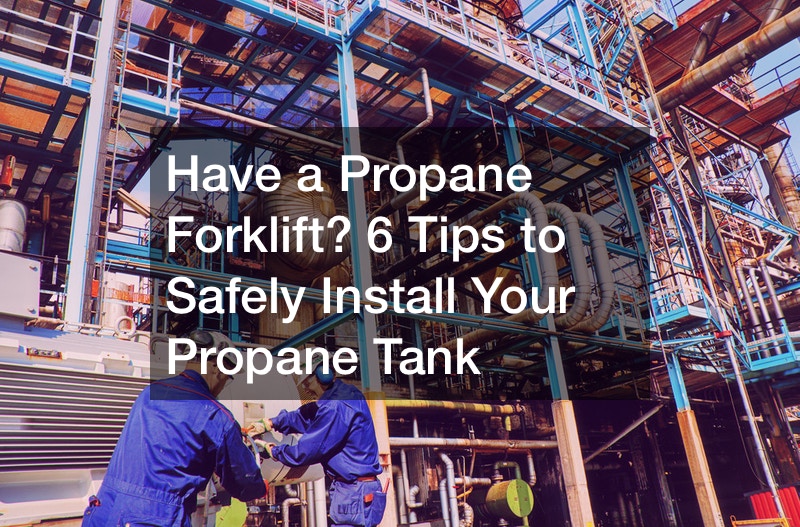
There’s no doubt that liquid propane is the most powerful and cost-effective fuel you can use to power your forklift and other machines. However, it’s also quite dangerous, and it should be handled with care. Liquid propane is probably one of the most flammable substances. To safely install a forklift propane tank, you need to know and understand each step of the process so you can ensure your safety and that of your coworkers.
If you are hiring from a forklift rentals service, it’s important to ask how the tank is changed first before you take the forklift with you. If you are not familiar with the process, you should let the forklift providers change it for you. It’s understandable that they can sometimes be too far, but you can get someone knowledgeable if you search for forklift rental nearby.
It’s crucial to understand the hazards of working with liquid propane. This fuel is kept inside the tank at high pressure, and coming into contact with it can damage the eyes and cause frostbite. Therefore, it’s advisable to have the right safety equipment like glasses and thick rubber gloves. It would be better if the tank installation was carried out by someone with a forklift operator licence. You must also know that liquid propane is not only flammable, but it can travel long distances and accumulate in a propane vapor pool. So, before you start the process of installation, you must ensure that there are no traces of fuel in the line and fitting of the forklift. You must also make sure that you do everything in an area with proper ventilation.

It is important to be careful when you are installing a liquid propane tank.Propane is a very versatile fuel. Hank Hill is not the only one to appreciate it. In the United States, nearly 60 million people use it on a regular basis. That number translates to 8.1 million homes across the country using it for a variety of reasons. Approximately 4.6% of all American homes use propane as their main fuel for heating their houses. Propane can exist in several forms. When it is in a tank or cylinder, it can be either a vapor or a liquid. When it is in the vapor form, it can be released as a fuel that burns cleanly. When it is in its liquid form, it is condensed to be about 270 times more compact than when it is in its gas form. This means it is a lot more efficient to transport propane as a liquid. Many industrial and agricultural sites across the country use equipment that is powered by propane. Propane forklifts, for example, are popular.
- Wear and use the right protective clothing and equipment. As has been noted, when propane fuel is in its liquid form, it is under a very high pressure and a very low temperature. When you transport propane in this form, it is kept at more than 44 degrees below zero Fahrenheit. It has to be kept under that temperature because that is the boiling point of liquid propane. When you install a liquid propane tank for propane forklifts and other uses, you need to wear protective clothing and eye protection as contact with the skin can cause frostbite. /li>
- Drain all remaining fuel from the equipment. When you change the tank on propane forklifts and other equipment, you would be making a mistake if you assume there is no more fuel in the system. Check both the line and the fitting are completely empty. If there is some propane in the system, it can spray and injure you or others in the area when you go to disconnect the coupler.
- Store the propane tanks properly. Start by unscrewing the fitting from the tank. Take the empty tank and put in the proper propane tank storage area.
- Make sure the new tank has no leaks. If your propane services company has delivered a propane tank with any issue that causes it to leak, you can have an explosion. Check your propane tanks carefully for any dents, rush spots, frost build up problems, gouges and the condition of your o-ring. Inspect your fitting and lift truck hose for any damage that you can see. Do all of this before you even consider installing the tank on any propane forklifts.
- Check the position of the tank. Place your propane tank on the locating pin. Propane forklifts have locating pins for several reasons. They are there to properly position the filling alignment and hose connect correctly without stretching or twisting the hose. It is needed to ensure the pressure valve will not spray the propane and hurt someone. It is there to align the main valve pick up tube to make sure you can reach all of the propane fuel that may pool at the bottom of the tank. Lastly, you need the locating pin to help make sure you get the right reading from the fuel gauge.
- Pay attention to how the tank looks, smells and sounds. If there is a smell coming from the tank, there is white frost or you hear sounds that you should not hear such as rushing noises, you should stop what you are doing. These are all indications that you have a leak, which can be deadly. Turn off the valve and get the area well ventilated. Liquid propane will pool on the ground because it is heavier than the air.
Propane is a safe fuel when you pay the appropriate attention to your tanks and take the right steps to stay safe when installing them. A lot of this is just using common sense, if you think something is wrong with a tank, you are probably right.
andnbsp;
andnbsp;







Leave a Reply
You must be logged in to post a comment.